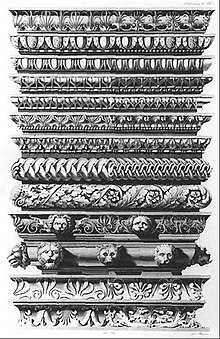Role models for manufacturers and craftsmen

The sample books “Role Models for Manufacturers and Craftsmen” appeared between 1821 and 1837 in Berlin. According to the will of its initiators, this extensive collection of images, mainly of ancient forms and patterns, was intended to support the beginning industrialization of Prussia as an aesthetic guide for trade schools and producers . Aloys Hirt , who wrote the book Architecture according to the principles of the elderly (panels): Fifty copper panels on architecture according to the principles of the elderly - Berlin, 1809 , should be mentioned as a pioneer and source of inspiration for these works .
The conditions
At the beginning of the 19th century, Prussia was technically and economically backward by decades, compared to the situation in England, for example. A protectionist economic system of import tariffs and export promotion protected the producers, but also slowed down their own initiative. Then there was the turmoil of the Napoleonic wars and an almost medieval organization in guilds . The so-called Stein - Hardenberg reforms then provided the legal framework for a new development. Serfdom and compulsory guilds ceased to exist (1807 and 1810), as did traditional protective tariffs and import bans (1818). Additional state aid measures should facilitate the transition to an industrial society. The high ministerial official Christian Peter Wilhelm Beuth founded the “ Association for the promotion of industrial diligence in Prussia ”, modernized and intensified industrial training, and had machines and technical knowledge imported. In this context, as head of the technical deputation for trade, he and his long-time friend, the painter and architect Karl Friedrich Schinkel , published the "Role Models for Manufacturers and Craftsmen".
The work
With these illustrations, Beuth and Schinkel wanted to exert “an influence on the development of taste” of the manufacturers of goods of all kinds and enable them to produce aesthetically high-quality and internationally competitive products industrially. Newer techniques such as iron art casting, zinc casting and the manufacture of terracotta had only just become possible in large numbers at low cost. Beuth and Schinkel welcomed this development, since “an easy, faithful reproduction of the work of art enables its general distribution among all classes; if knowledge of this can no longer only be acquired in museums, in inaccessible private collections, then one can hope that from the seed so sown a grain will occasionally sprout and bear fruit ” . However, the editors did not intend to develop the imagination and creativity of the users with their templates : "The manufacturer and craftsman should, we repeat, not be tempted to compose themselves, but to imitate diligently, faithfully and with taste" .
In keeping with the main artistic trend of the time - classicism - Beuth and Schinkel recommended applying patterns from classical antiquity to everyday objects of all types and sizes, from craft objects to steam engines . Between 1821 and 1837, a total of 151 large-format copperplate engravings were published in two volumes . The entire work was divided into three sections; the most extensive first contains “architectural and other decorations”, the second “tools, vessels and smaller monuments ”, both refer to examples of art from antiquity - to architectural forms such as capitals and friezes , to ceramic vessels and bronze devices. The third section, “ Models for the decoration of witnesses and for knitting in particular”, that is for textiles of all kinds, was least oriented towards antiquity ; here many suggestions were borrowed from the Islamic Orient . A separate volume of text contained an introductory text on each section and a commentary on each board. In the foreword Beuth wrote: "Those who deliver the most efficient and at the same time the most beautiful goods can count on secure, lasting sales ...".
In an art catalog from 1850, the employees are named by the “models…”: “This excellently executed… work, each sheet of which bears the K (royal) Preuss (is) stamp, is based on drawings by Schinkel, Mauch, Ruhl, Pretre and others . A. engraved by Caspar, Anderloni, Sellier, Ruscheweyh , H. Moses, Funcke, Lowry and other famous engravers ” . - Johann Wolfgang von Goethe praised the "role models ..." for their "excellent purity and delicacy" and for the cleanliness of the print. For a long time the work had a great influence on the product design of Prussian manufacturers, until the 1860s it was repeatedly reissued. In the meantime, however, the focus was less and less on the ancient forms of classicism, but instead often imitated Romanesque and Gothic models. Towards the end of the 19th century, tendencies arose in which the focus was no longer on imitation, but on the development of independent aesthetic principles ( Arts and Crafts Movement , Art Nouveau ).
Based on the famous title, Alexander von Minutoli in Liegnitz, a former student of the Berlin Building Academy, published paper prints of photographs from his collection from 1854/1855 to 1868 as models for craftsmen and manufacturers .
Web link
Text volume 1st part 1821-1830 and 2nd part 1837 in the Google book search
Individual evidence
- ↑ Architecture according to the principles of the elderly (panels): Fifty copper plates on architecture according to the principles of the elderly - Berlin, 1809 ( citation link from Heidelberg University Library )
- ↑ http://www.kunstportal-pfalz.de/veranstalter_archiv_details.php?ID_va=22&id=348 ( page no longer available , search in web archives ) Info: The link was automatically marked as defective. Please check the link according to the instructions and then remove this notice.
- ↑ like 1.
- ↑ Rudolph Weigel's art catalog, Leipzig 1838, corrected edition 1850
- ↑ Margret Dorothea Minkels, Zygmunt Wielowiejski: Alexander von Minutoli, the founder of the 1st Museum of Applied Arts in the world . Norderstedt 2018, ISBN 978-3-7460-6982-1 , p. 321-325, 335-369, 370-376, 437-442, 511 f., 632, 634-649, 659, 664-682, 685-687, 689-691 .
